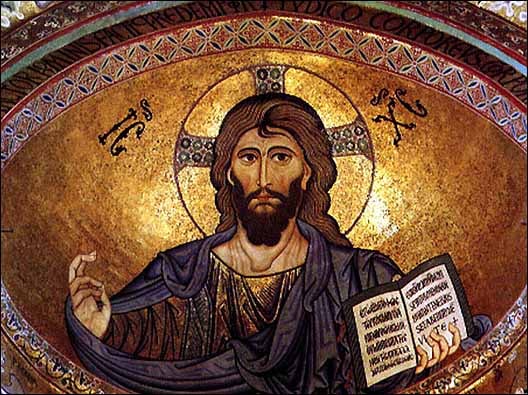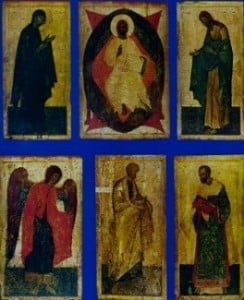
By Catherine Tsounis
Catherine Tsounis is a published author of Greek descent and a travel enthusiast who gives us insight into the Byzantine influence in Russia through her recent travels there.
From late September to early October, I saw the masterpieces of Theophanes through my Moscow guide Irina and St. Petersburg guide Olga, arranged by expresstorussia.com and intourist.com.
Theophanes the Greek was born in the 1330’s. Information on the career of this outstanding Byzantine painter is available only from Russian sources – Novgorod and Moscow chronicles a letter written in approximately 1415 by the Moscow religious author Epiphanius the Wise who personally knew the artist.

In Russian, he is called “Feofan Grek”and believed to be one of the greatest icon painters of Muscovite Russia. He was the teacher and mentor of the great Andrei Rublev. Theophanes was born in the capital of the Byzantine Empire, Constantinople. He studied Art and Philosophy at the University of Constantinople. Before his arrival to Russia, Theophanes worked in Constantinople, Chalcedon, Galata and Kafa (Feodosiya in the Crimea) where he executed murals for more than forty churches. He introduced to Russia progressive Byzantine art – vigorous, picturesque and demonstrating great creative freedom. In his works light is an active element that gives life to human forms. In 1378 Theofanes the Greek decorated the Church of the Transfiguration on Ilyin Street in Novgorod. It is the basis for art historians for identifying his other works.

On my last day in Russia, October 3, we went on an eight-hour round ride to Veliky Novgorod from St. Petersburg with guide Olga (olgamelnyandex.ru). We met with Novgorod guide Dmitri (dmitri1548@yandex.ru) and went off the beaten trail: to the Church of the Transfiguration on Ilyin Street. We noticed the domes were different from other churches. “They are shaped like helmets and are closer to Byzantine domes,” explained Olga. “The church was built in the Byzantine style.” The current building was built in 1374 and frescoed by Theophanes the Greek (Feofan Grek or Феофан Грек in Russian) in 1378. Substantial portions of those frescoes still remain, including the Christ Pantocrator in the dome, a number of saints inside the south entrance, and The Old Testament Trinity in the western vestry, as well as others.
The current building is now a museum, part of the Novgorod State Museum-Preserve. The Icon of Our Lady of the Sign was originally housed there. Part of the original Greek brick exterior is displayed.

The most breathtaking painting in the temple is a half-figure image of Christ Pantocrator in the dome. Frescoes in the Transfiguration Church have remained partially only. Most of them have been lost but what remains is the only monumental works by Theophanes the Greek survived in the world. However, even small pieces of frescoes make it possible to appraise both an overall design of the ensemble and the unique brushwork of Theophanes that Epiphanius called «unknown and unusual painting technique».”
Around 1395, Theophanes moved to Moscow where he decorated churches, private houses, designed book manuscripts. Epiphanios the Wise described Theophanes work as extraordinary. “When he was drawing or painting, nobody saw him looking at existing examples, as would do some of our icon painters. He appeared to paint his frescoes with his hands while walking back and forth, talking to visitors.”

Theophanes’ style in icons differed greatly from his style in murals. In icon painting he mainly used beautiful and saturated colors and pure forms, laying the foundations for mature Moscow icon painting). Theophanes must have painted many icons throughout his life, but based on historical evidence, scholars believe that the following nine are his: The Virgin of the Don and The Dormition of the Virgin (Novgorod period), The Savior in Glory, The Virgin Mary, St. John Chrysostom, Archangel Gabriel, St. Paul, St. Basil, and St. John the Baptist, all of which were painted in 1405 for the Deesis tier in Moscow’s Cathedral of Annunciation. It was the first iconostasis in Russia in which the figures of the saints were presented at full-height.
This iconostasis might not be the original of 1405 and could have been brought to the Annunciation Cathedral after its restoration in 1547, when a devastating fire destroyed most of the icons. Nonetheless, the iconographic style, the use of various difficult drawing methods and the high spirituality of the icons suggest that they were painted by the talented master Theophanes. This is the tragedy of the Fall of Byzantium in 1453: loss of civilization records, architecture, and art work.
See all the latest news from Greece and the world at Greekreporter.com. Contact our newsroom to report an update or send your story, photos and videos. Follow GR on Google News and subscribe here to our daily email!



